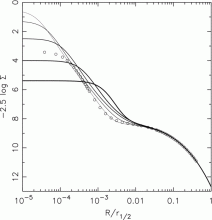
Abstract
The young stars near the supermassive black hole at the galactic center follow orbits that are nearly random in orientation and that have an approximately thermal distribution of eccentricities, N(e)~e. We show that both of these properties are a natural consequence of a few million years' interaction with an intermediate-mass black hole (IBH), if the latter's orbit is mildly eccentric and if its mass exceeds approximately 1500 solar masses. Producing the most tightly-bound S-stars requires an IBH orbit with periastron distance less than about 10 mpc. Our results provide support for a model in which the young stars are carried to the galactic center while bound to an IBH, and are consistent with the hypothesis that an IBH may still be orbiting within the nuclear star cluster.